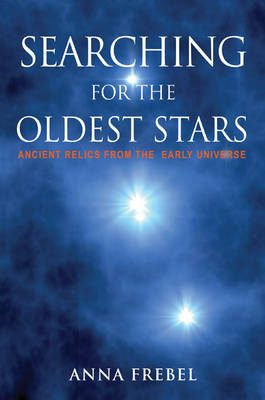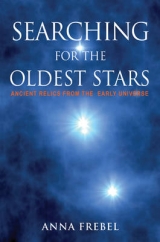Searching for the Oldest Stars
Princeton University Press (Verlag)
978-0-691-16506-6 (ISBN)
- Titel ist leider vergriffen;
keine Neuauflage - Artikel merken
Astronomers study the oldest observable stars in the universe in much the same way that archaeologists study ancient artifacts on Earth. Here, Anna Frebel--who is credited with discovering several of the oldest and most primitive stars using the world's largest telescopes--takes readers into the far-flung depths of space and time to provide a gripping firsthand account of the cutting-edge science of stellar archaeology. Weaving the latest findings in astronomy with her own compelling insights as one of the world's leading researchers in the field, Frebel explains how sections of the night sky are "excavated" in the hunt for these extremely rare relic stars--some of which have been shining for more than 13 billion years--and how this astonishing quest is revealing tantalizing new details about the earliest times in the universe. She vividly describes how the very first stars formed soon after the big bang and then exploded as supernovae, leaving behind chemical fingerprints that were incorporated into the ancient stars we can still observe today.
She shows how these fingerprints provide clues to the cosmic origin of the elements, early star and galaxy formation, and the assembly process of the Milky Way. Along the way, Frebel recounts her own stories of discovery, offering an insider's perspective on this exciting frontier of science. Lively and accessible, this book sheds vital new light on the origins and evolution of the cosmos while providing a unique look into life as an astronomer.
Anna Frebel is the Silverman (1968) Family Career Development Assistant Professor in the Department of Physics at the Massachusetts Institute of Technology. She has received numerous international honors and awards for her discoveries and analyses of the oldest stars. She lives in Cambridge, Massachusetts.
Preface xi An Introductory Remark xv 1 What Is Stellar Archaeology? 1 1.1 The First Minutes after the Big Bang 2 1.2 Stellar Archaeology 7 2 Two Centuries of Pursuing Stars 10 2.1 First Glimpses of Stellar Rainbows 11 2.2 Decoding Starlight 16 2.3 A New Perspective of the Cosmos 22 2.4 Looking into the Hearts of Stars 29 2.5 Modern Alchemy 35 2.6 The Foundation of Cosmology 38 2.7 The Origin of the Elements 44 3 S tars, Stars, More Stars 51 3.1 The Cycle of Matter in the Universe 51 3.2 Astronomers and Their Metals 55 3.3 Element Nucleosynthesis in the Cosmic Kitchen 59 3.4 Stellar Diversity 73 4 Stellar Evolution-From Birth to Death 78 4.1 Sorting Stars 78 4.2 A Protostar Forms 85 4.3 The Evolution of a Low-Mass Star 88 4.4 The Evolution of a Massive Star 93 4.5 Supernovae and Supernova Remnants 95 4.6 Preliminary Thoughts about Working with Metal-Poor Stars 102 5 Neutron-Capture Processes and the Heaviest Elements 107 5.1 How Neon Lamps Relate to Giant Stars-Element Synthesis in the S-Process 109 5.2 Thorium, Uranium, and R-Process Element Synthesis 114 5.3 Cosmo-Chronometry: The Oldest Stars 120 5.4 Nuclear Astrophysics 128 6 Welcome to Our Milky Way 130 6.1 A Milky Way above Us 130 6.2 The Milky Way's Structure 133 6.3 Dwarf Galaxies 139 6.4 Star Clusters 145 6.5 Naming Stars 151 7 Tales Told by Light 155 7.1 A Little Lexicon of Light 156 7.2 Spectroscopy-Deciphering Starlight 160 7.3 Element Abundance Analyses of Stars 166 7.4 The Largest Telescopes in the World 173 7.5 Three Steps toward Success 180 7.6 Observations with MIKE 186 8 Let's Go Ob serve Some Stars! 192 8.1 Going Stargazing 192 8.2 Good-Weather Beer 197 8.3 A Sunset 198 8.4 The Observa-thon 201 8.5 One Hundred and Five Stars per Night 203 8.6 Computers, Computers ... 205 8.7 Tested by Fire 207 9 The Chemical Evolution of the Early Universe 210 9.1 The First Stars in the Universe 210 9.2 The Family of Metal-Poor Stars 217 9.3 The Most Iron-Poor Stars 222 9.4 The Cosmic Chemical Evolution 227 10 Finding the Oldest Stars 241 10.1 Pursuing Metal-Poor Stars 241 10.2 Bright Metal-Poor Stars 248 10.3 Mt. Stromlo Succumbs to Bushfires 252 10.4 The Discovery of a Record-Breaking Most Iron-Poor Star 257 10.5 The Astronomical Community 264 11 A t the End of a Cosmic Journey 267 11.1 Cosmological Simulations 267 11.2 Where Do Metal-Poor Stars Come From? 273 11.3 Expectations of Future Surveys 279 11.4 The Next Generation of Giant Telescopes 282 11.5 Little Diamonds in the Sky 285 Further Reading 287 Index 289
| Zusatzinfo | 51 color illus. 5 halftones. 57 line illus. 8 tables. |
|---|---|
| Verlagsort | New Jersey |
| Sprache | englisch |
| Maße | 152 x 235 mm |
| Gewicht | 680 g |
| Themenwelt | Naturwissenschaften ► Physik / Astronomie ► Astronomie / Astrophysik |
| ISBN-10 | 0-691-16506-8 / 0691165068 |
| ISBN-13 | 978-0-691-16506-6 / 9780691165066 |
| Zustand | Neuware |
| Haben Sie eine Frage zum Produkt? |
aus dem Bereich




